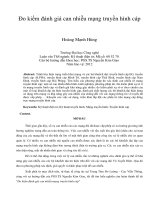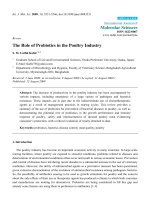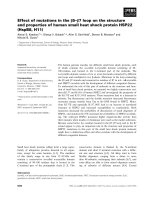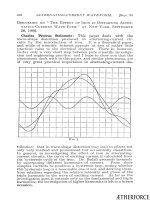Effect of cold storage on viability of probiotics in non dairy probiotic beverage based on carrot and tomato juice
Bạn đang xem bản rút gọn của tài liệu. Xem và tải ngay bản đầy đủ của tài liệu tại đây (173.17 KB, 7 trang )
Int.J.Curr.Microbiol.App.Sci (2019) 8(3): 2028-2034
International Journal of Current Microbiology and Applied Sciences
ISSN: 2319-7706 Volume 8 Number 03 (2019)
Journal homepage:
Original Research Article
/>
Effect of Cold Storage on Viability of Probiotics in Non Dairy Probiotic
Beverage Based on Carrot and Tomato Juice
A. Shaikh Uzma*, H.W. Deshpande and D.B. Kulkarni
Department of Food Microbiology and Safety, College of Food Technology, Vasantrao Naik
Marathwada Krishi Vidyapeeth, Parbhani - 431402 (Maharashtra) India
*Corresponding author
ABSTRACT
Keywords
L. acidophilus,
S. boulardii,
Temperature,
Probiotic beverage,
Cell viability
Article Info
Accepted:
15 February 2019
Available Online:
10 March 2019
The carrot and tomato juice (70:30) with 180Bx inoculated using 10% mixed
culture of L. acidophilus and S. boulardii (1:1) and fermented for 20 hours.
The microbiological analysis showed that prepared beverage contained
optimum level of cultures i.e. 8.5 x109 CFU/mL and yeast and mold 4.5x109
CFU/mL was free from any traces coli-form bacteria. The loss of viability of
probiotic cells that is L. acidophilus and Sacchromyces boulardii cultures were
observed in beverage stored at refrigeration conditions for 28 days. It is studied
that the viability of cultures decreased during storage, but the count was within
the limits (107-109) that is L. acidophilus 4.7 x 107 and S. boulardii 4.5 x 107.
Introduction
Probiotic is the word means “for life” and it is
generally used to name the bacteria associated
with the beneficial effects for humans and
animals. Probiotication is one of the methods
to produce fermented functional foods.
Addition of probiotics to food provides
several health benefits including reduction in
the level of serum cholesterol, improvement
of gastrointestinal function, enhancement of
immune system and reduction in risk of colon
cancer (Burner and Donnel, 1998).
The development of probiotic beverages or
products in food industry has gained
importance for the last two decades.
Considerable research and scientific findings
on probiotic products have been well
documented. The term probiotics was first
used by Lilly and Stillwell in 1967, although
this concept existed since ancient Greek
times. Probiotics represent over 65 per cent of
the functional food market (Agrawal, 2005).
Probiotics are live microorganisms that are
similar to beneficial microorganisms found in
the human gut. They are also called "friendly
bacteria" or "good bacteria". Probiotics are
2028
Int.J.Curr.Microbiol.App.Sci (2019) 8(3): 2028-2034
available to consumers mainly in the form of
dietary supplements and foods. They can be
used as complementary and alternative
medicine (CAM) (Prado et al., 2008).
World Health Organization and the Food and
Agriculture Organization of the United
Nations defined that probiotics as "live
microorganisms, which, when administered in
adequate amounts, confer a health benefit on
the host". The majority of products containing
probiotics are dairy-based, which include
yogurt and fermented milk beverage. In the
last decade, there is an increasing interest in
using nondairy ingredients as substrates for
certain strains of lactic acid bacteria to deliver
the physiological benefits of probiotics to
wider group of consumers. A commercial
probiotic product is considered as functional
only if it contains 107 CFU/ml at the time of
consumption (Charalampopoulos et al.,
2002).
Probiotic
foods
and
beverages
are
manufactured by either method: (a) by adding
the probiotic strains simultaneously with the
standard cultures in the fermentation tank; (b)
by adding the probiotic culture directly into
nonfermented final products. Generally,
species of Lactobacillus and Bifidobacterium
are used in most of the probiotic applications.
However, due to some drawbacks related to
dairy products, there are emerging interests in
using non-dairy ingredients as substrates for
delivering the physiological benefits of
probiotics to wider group of consumers
(Prado et al., 2008).
Carrots have also a unique combination of
three flavonoids: kaempferol, quercetin and
luteolin. They are also rich in other phenols,
including chlorogenic, caffeic and phydroxybenzoic acids along with numerous
cinnamic
acid
derivates.
Among
hydroxycinnamic acid and its derivates,
chlorogenic acid represents 42.2% to 61.8%
of total phenolic compounds detected in
different carrot tissues. Carrot juice contains
carbohydrates, dietary fiber, protein, fat,
Vitamins A, C, B1, B2, B3, B6 and E. It also
contains traditional antioxidants such as
ascorbic acid, phytonutrient and beta-carotene
(Gopalan et al., 1996).
Tomato (Solanum lycopersicum Mill.)
belonging to the family Solanaceae and is the
most important warm season fruit vegetable
both nutritionally and economically grown
throughout the world. It is one of the most
important "protective foods because of its
special nutritive value and its widespread
production (Kavya, 2013). Among the
processed tomatoes, juices may also be
considered as health-promoting beverages
(Naga et al., 2016).
Since, in addition to being delicious and
nutritious, the carrot and tomato juice may be
an excellent medium for the supplementation
of existing nutraceutical components with
probiotic culture.
Thus, pertaining to the above discussion, in
response to the demand from increasingly
health conscious consumers for nutritive
value and medicinal properties of carrot and
tomato therefore for developing probiotic
carrot and tomato beverage all steps and
protocol are given in this research.
Materials and Methods
Preparation of carrot and tomato juice
Freshly harvested carrot and tomato fruits
were procured from local market of Parbhani
(Maharashtra). Carrot and Tomato juice was
prepared by blanching of carrot and Tomato
at 600C for 20 min. Then blend the juice in
ratio of 70:30 of carrot and tomato juice. Its
soluble solids was maintained to 180Bx, add
stabilizer xanthan gum (0.2%) and stored at
40C before use.
2029
Int.J.Curr.Microbiol.App.Sci (2019) 8(3): 2028-2034
Probiotic strains
Sensory analysis of probiotic beverage
Probiotic isolates, Lactobacillus acidophilus
and Sachharomyces boulardii were identified
using phenotypic and genotypic methods in
Department of Food and Industrial
Microbiology, College of Food Technology,
VNMKV, Parbhani. Stock solution was
prepared by adding sterile glycerol (50% v/v)
to the activated culture. The glycerol stock
culture was stored at -20 0C in sterile screw
cap tubes.
The sensory evaluation of carrot and tomato
based probiotic beverage was carried out by
10 semi-trained panel members comprised of
postgraduate students and academic staff
members of the faculty who had some
previous experience in sensory evaluation.
The panel members were requested in
measuring the terms identifying sensory
characteristics and in use of the score.
Judgment were made through rating products
on a 9 points Hedonic Scale with
corresponding descriptive terms ranging from
9 “like extremely” to 1 “dislike extremely”
with respect to different quality attributes
such as colour, flavour, taste, aroma,
mouthfeel and overall acceptability.
Preparation of starter culture
The starter culture was prepared with the help
of method described by Thakur M and
Sharma (2017), with slight modifications. L.
acidophilus and S. boulardii was cultivated
separately in the MRS broth and Potato
Dextrose Broth for 24-h at 370C. To obtain
the biomass, 10 mL of the separately
cultivated MRS broths (5ml) and Potato
dextrose broth (5ml) were mixed in equal
proportion (1:1) and centrifuged at 4000 rpm
for 10 min. The obtained biomass was washed
with sterile saline solution twice to remove
the residual MRS media and Potato dextrose
media. Thus, inoculum was prepared.
It was then introduced into pasteurized carrot
and tomato juice blend (100 mL) for making
it 10% concentration of probiotics. The
inoculated juice was then incubated at 370C
for 24 h and was treated as starter culture for
preparation of final beverage.
Preparation of probiotic beverage
Above prepared starter culture (10mL) was
then added to the pasteurized (at 780 C for 30
min) carrot and tomato juice blend (100 mL)
to obtain 10% inoculation. It was allowed to
ferment in incubator at 370C for 20 h. After
incubation, the beverage was kept at
refrigeration temperature for future use.
Statistical analysis
All processing equipments and analysis of
samples were run in triplicate. Analysis of
variance was calculated using standard
ANOVA procedure. The data obtained for
various treatments was recorded and
statistically analyzed by complete randomized
design (CRD) to find out the level of
significance as per the method proposed by
Panse and Sukhatme (1957). The analysis of
variance revealed at significance at P< 0.05
level. The standard error (SE) and critical
difference (CD) at 5 % level were mentioned
where required.
Microbial analysis of probiotic beverage
The viable count of mixed culture was
determined by the standard plate count
method using Man-Rogosa-Sharpe agar
(MRS agar) and the results were expressed as
CFU/ml juice. The yeast and mold count of
beverage was determined using potato
dextrose agar medium. The coli-form and
basically E. coli are the indicator microbes of
water contamination by feces. The coli-form
2030
Int.J.Curr.Microbiol.App.Sci (2019) 8(3): 2028-2034
gives red pink color colonies on the
MacConkey agar. Plates were incubated at
370C for 48-72 hours (Chris et al., 2006).
Results and Discussion
In the present work, the count of beneficial
bacteria was detected as 8.5 x109 CFU/mL
and 4.5x109 CFU/mL of yeast and mold
beverage. This count was in range for a
product to be called as probiotic (shah N.P
2001).
Sensory evaluation of probiotic beverage
The probiotic beverage were used to sensory
analyzed because the overall acceptability of
the developed probiotic beverage is to be
checked by different sensory evaluation panel
and find out which is more delicious and tasty
out of 6 prepared samples having different
fermentation periods 12, 16, 20, 24, 28 and 32
hrs respectively.
The data in the Table 1 shows that, no
significant effect was found among various
treatments for appearance, color and
consistency. The sample MIT3 was most
preferred in terms of taste and flavour while
MIT1 was least preferred. The MIT3 sample
was preferred because of higher metabolic
activity
of
probiotics
in
enhanced
fermentation period, as said above. Its mean
scores for taste, flavour and overall
acceptability were 8, 8 and 8, respectively,
which were significantly higher (p<0.005)
than other samples. The values of taste and
flavor for MIT1 sample were 6.5 and 6.8
respectively. The overall acceptability values
for all samples varied from 6.5 (MIT1) to 8
(MIT6). As observed from it, the most
preferred sample by panelists was MIT3.
Microbial analysis of probiotic carrot and
tomato beverage
The growth of undesirable organisms will
spoil the product and may lead to food borne
diseases affecting the healthy lives. Therefore,
performing microbial analysis is mandatory in
probiotic based products to assess their safety.
The data related to microbiological analysis
of probiotic beverage is tabulated in Table 2.
On the other hand, coli-form count was also
determined. And they were not detected in the
sample, which showed that the product was
free of any pathogenic microbes and safe for
consumption.
Effect of storage on viability of probiotics
It is imperative from a health view-point that
probiotic strains selected for commercial use
retain their viability and functional activity
throughout the shelf-life of the delivery
product. Therefore, the viability of the lactic
cultures is the most important factor during
refrigerated or ambient storage which is
dependent on the level of oxygen in products,
oxygen permeation of the package,
fermentation time, and storage temperature.
The changes in the counts of probiotic
microorganisms during the storage are
presented in Table 3.
From the Table 3, it is observed that the
probiotic cultures were capable of surviving
in the product at 4oC for 28 days as shown
above. The initial microbial population of L.
acidophillus (TPC) was 8.5 x109 CFU/mL
and Yeast and Mold that is, Sachharomyces
boulardii was 4.5x109 just after fermentation.
The viable count reduced over the storage
period. At the end of 28 days, the microbial
count (TPC) reduced to 4.7 x107 CFU/mL and
4.5x107 of saccharomyces boulardii was
detected in sample stored at refrigerated
temperature (4oC). Temperature, which
enhances the mortality effect of organic acids,
is one of the most important factors on the
viability of probiotics. The cell wall of lactic
acid bacteria consists of saturated, unsaturated
2031
Int.J.Curr.Microbiol.App.Sci (2019) 8(3): 2028-2034
and cyclic carbon chains, which will vary
depending on parameters like temperature,
pH, NaCl concentration and medium content.
Linoleic and oleic synthesis will occur at
acidic situations. These acids will absorb
hydrogen in an acidic environment increasing
the permeability of proton in membranes, and
therefore, leading to viability increase when
confronted with hostile conditions throughout
acidic situation during storage at refrigeration
temperature (Sheehan et al., 2007).
From the standpoint of consumer's health
benefits, the selected probiotic cultures must
maintain their viability and functionality
during the product storage period (Sheehan et
al., 2007). For the maximum health benefits,
the minimum number of probiotic organisms
in a food product should be 106 CFU/g (Shah,
2001). In the present investigation, the
microbial count was detected higher than this
limit for this sample and count was
significantly higher in sample throughout the
storage period.
The viability losses or the reduction of
probiotics’ count may be due to the decrease
of pH values, post process acid production
(Wang et al., 2002), sensitivity to oxygen
(Frank et al., 1988) and metabolites such as
hydrogen peroxide and ethanol and to
bacteriocins produced by lactic acid bacteria
(Medina and Jordano, 1994).
When probiotic cells are present in low pH
environments (<4.5), increased energy is
required to maintain the intracellular pH,
resulting in a lack of ATP for other critical
functions and thereby causing cell death
(Nualkaekul et al., 2011). In addition, because
probiotics are devoid of the electron transport
chain and/ or catalase enzyme; the presence of
oxygen can cause formation and accumulation
of toxic metabolites in cells, which can lead to
cell death by oxidative damage (Boza
Mende’z et al., 2012; Talwalkar and
Kailasapathy,
2004).
The
continuous
exposure to oxygen under acidic conditions
during storage is the main reason for the
reduction in probiotic counts (Sheehan et al.,
2007).
The viable cell population of L. plantarum
and L. delbrueckii remained at an acceptable
level (106 CFU/mL) after one week of cold
storage, but their microbial population
decreased below the minimum accepted after
2 weeks (Yoon et al., 2005).
Table.1 Organoleptic evaluation of probiotic carrot and
tomato beverage (on 9 point hedonic scale)
S. No.
Samples
Appearance
Color
Taste
Flavor
Consistency
1
2
3
4
5
6
MIT1
MIT2
MIT3
MIT4
MIT5
MIT6
F-value
SE±
CD
at
5%
7.5
7.6
8
7.8
7.9
7.6
7.8
7.8
8
7.8
7.9
7.8
NS
6.8
7
8
7.5
7.6
7.2
28.650
0.0816
0.2512
7.6
7.7
8
7.8
7.9
7.6
NS
6.5
6.9
8
7.4
7.5
7
41.650
0.0816
0.2512
- Each value is an average of ten determinations
2032
NS
Overall
Acceptability
6.5
6.8
8
7.3
7.4
7
41.200
0.0816
0.2512
Int.J.Curr.Microbiol.App.Sci (2019) 8(3): 2028-2034
Table.2 Microbial analysis of probiotic beverage
S. No.
Parameters
Observations
1
2
3
Total plate count (CFU/mL)
Yeast and mold count (CFU/mL)
Coli-form count (MPN/mL)
8.5 x109
4.5x109
ND
Table.3 Effect of storage during 4 weeks on viability of probiotic cultures in probiotic carrot and
tomato beverage at 40C
Sr. No. Parameters
(CFU/mL)
1.
2.
L. acidophilllus
S. boulardii
Storage Period
0# Day
7 Days
14 Days
21 Days
28 Days
8.5 x109
4.5 x109
5.3 x108
1.2 x 108
9.3x107
8.9x107
4.7 x107
4.5 x 107
2.5x109
8.3x 108
-Each value is an average of three determinations
#
- Just after fermentation/incubation
ND - not detected
In conclusion, the pasteurized carrot and
tomato juice (70:30) was inoculated with
probiotic cultures (10%) of L. acidophilus and
S. boulardii (1:1) and fermented for 20 hrs)
was found to be most appropriate to improve
the quality of beverage. Then, the prepared
beverage was analyzed for microbiological
characteristics. It was then stored in
refrigeration temperature. The loss of viability
of probiotic cells that is L. acidophilus and
Sacchromyces boulardii cultures were
observed in beverage stored at refrigeration
conditions for 28 days. Microbiological
analysis found that the beverage contained the
desired
level
of
probiotic
cultures
(109CFU/mL) which is helpful for
maintaining the health of gastro intestinal
tract. It is found that the viability of cultures
decreased during storage, but the count was
within the limits (107-109) that is L.
acidophilus 4.7 x 107 and S. boulardii 4.5 x
107. Further, the prepared beverage didn’t
contain any traces of coli-form bacteria, thus
indicating that beverage is containing only
health benefitting bacteria.
References
Agrawal R. (2005). Probiotics: An emerging
food supplement with health benefits.
Food Biotech., 19: 227-246.
Boza-Mendez, E., Lopez-Calvo, R. and
Cortes-Munoz, M. (2012). Innovative
dairy products development using
probiotics: challenges and limitations.
In: Rigobelo, E. C. (Ed.). Probiotics.
InTech. DOI: 10.5772/3444.
Burner L. and Donnel J. (1998) Functional
food and health claims legislation:
Applications to dairy foods. Int.
Dairy. J., 8: 355-362.
Charalampopoulos D., Pandiella S.S. and
Webb C. (2002).
Application of
cereals and cereal components in
functional
foods:
A
review.
International Journal of Food
Microbiology, 79: 131-14.
Chris B., Paul N. and Anthony P.W. (2006).
Food Microbiology and Laboratory
Practices. Blackwell Publishing, State
Avenue, USA.
Frank J. F. and Marth E. M. Fermentations.
2033
Int.J.Curr.Microbiol.App.Sci (2019) 8(3): 2028-2034
In: Wong, N.P., Jenness, R., Keeney,
M. and Marth, E. H. (1988).
Fundamentals of Dairy Chemistry.
(Eds.). Van Nostrand Reinhold Co.,
New York, pp: 655-738.
Gopalan C., Ramasastry B. V. and
Balasubramanian S. C. (1996).
Nutritive value of Indian foods.
National Institute of Nutrition. (NIN)
Hyderabad, 45-47.
Kavya S.E. (2013). Evaluation of Tomato
Varieties for Fermented Beverage and
Vinegar Production. Department of
Agricultural Microbiology, University
of Agricultural Sciences, Bengaluru.
Medina L. M. and Jordano R. (1994).
Survival of constitutive microflora in
commercially
fermented
milk
containing Bifidobacteria
during
refrigerated storage. J. Food Prot., 56:
731-733.
Naga S., Ramesh B., Umamahesh K. And
Vijaya S. (2016). Probiotication of
Tomato and Carrot Juices for Shelflife. Enhancement using Microencapsulation. Journal of Food
Biosciences and Technology, 6(2):1322.
Nualkaekul
S.,
Salmeron
I.
and
Charalampopoulos
D.
(2011).
Investigation of the factors influencing
the survival of Bifidobacterium
longum in model acidic solutions and
fruit juices. Food Chemistry, 129:
1037-1044.
Panse, V. G. and Sukhatme, P. V. (1957).
Statistical Methods for Agricultural
Workers.
Indian
Council
of
Agricultural Research, New Delhi.
Prado F. C., Parada J. L., Pandey A. and
Soccol C. R. (2008). Trends in nondairy probiotic beverages. Food Res.
Int., 41: 111-123.
Shah N.P. (2001). Functional foods from
probiotics and prebiotics. Food
Technology, 55(11): 46-53.
Sheehan V. M., Ross P. and Fitzgerald G. F.
(2007). Assessing the acid tolerance
and the technological robustness of
probiotic cultures for fortification in
fruit juices. Innovative Food Science
and Emerging Technologies, 8: 279284.
Talwalkar A. and Kailasapathy K. (2004).
The role of oxygen in the viability of
probiotic bacteria with reference to L.
acidophilus and Bifidobacterium spp.
Current
Issues
in
Intestinal
Microbiology, 5: 1-8.
Thakur M. and Sharma R. (2017).
Development
of
probiotic
pomegranate beverage and its
physico-chemical
and
microbial
characterization. International Journal
of Pure and Applied Bioscience, 5
(1):35-41.
Wang Y. C., Yu R. C. and Chou C. C. (2002).
Viability of lactic acid bacteria and
bifidobacteria in fermented soymilk
after drying, subsequent rehydration
and storage. Graduate Institute of
Food Science & Technology, National
Taiwan University Taipei, Taiwan.
Yoon K. Y., Woodams E. E. and Hang Y. D.
(2005). Fermentation of beet juice by
beneficial lactic acid bacteria.
Lebensm.-Wiss. u.-Technol., 38: 7375.
How to cite this article:
Shaikh Uzma, A., H.W. Deshpande and Kulkarni, D.B. 2019. Effect of Cold Storage on
Viability of Probiotics in Non Dairy Probiotic Beverage Based on Carrot and Tomato Juice.
Int.J.Curr.Microbiol.App.Sci. 8(03): 2028-2034. doi: />2034









